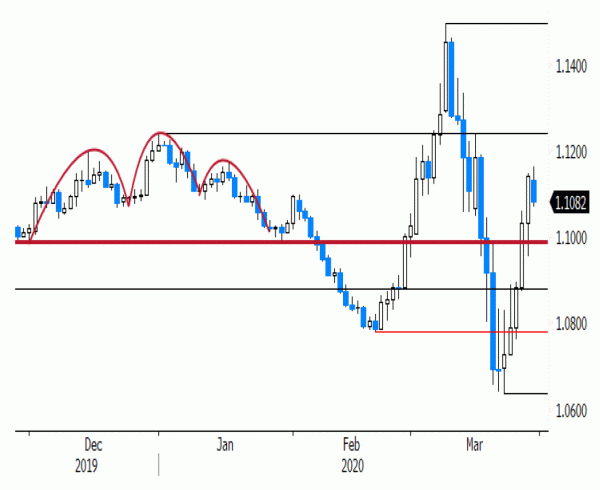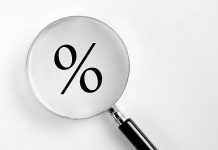- Rates: German 10-yr yield loses intermediate support
Core bond yield curves bull flattened significantly last Friday. President Trump’s vow to get back to business as usual by Easter was replaced an extension of quarantine measures until April 30. The German 10-yr yield fell below intermediate support. Equity weakness and lower oil prices could benefit core bonds further. - Currencies: did the dollar enter a sell-on-upticks pattern?
The dollar remained in the defensive on Friday, even as sentiment turned risk-off. End of quarter positioning might complicate USD trading. Even so, we don’t expect a new aggressive liquidity run on the USD. EUR/USD is currently holding above key support levels. Sterling also shows remarkable strength with EUR/GBP dropping below the 0.90 handle
The Sunrise Headlines
- WS snapped its 3-day winning streak on Friday. The DJ underperformed (-4%). Asian markets colour mostly red, Australia being a notable exception (+7%). The Australian government pledged to spend A$130 bn in a crisis reponse.
- The UK’s credit rating was downgraded by Fitch to AA- with a negative outlook. Fitch cited the volume of cash the Treasury is throwing at the corona-crisis and the continued uncertainty over the post-Brexit relation with the EU.
- The PBOC ramped up its response to the coronacrisis and cut the 7-day reverse repo from 2.4% to 2.2% when it injected CNY50 bn into the banking system, surprising given the central bank has been draining liquidity since 16 March.
- US president Trump extended social-distancing guidelines until 30 April after National Institute of Allergy and Infectious Diseases director Fauci starkly warned the number of US coronavirus deaths could climb as high as 200K.
- Moody’s downgraded South Africa’s credit rating to junk as a recession deepened by the impact of coronavirus torments reform efforts to reduce the country’s debt burden. The SA rand slid to record lows (USD/ZAR 18.09).
- Oil prices crashed to 17-year lows (WTI 19.92 bpd, Brent 23.03 bpd) as the fallout from the coronacrisis and the escalating Saudi Arabia-Russia price war overwhelms the market by cratering demand and a ballooning supply surplus.
- Today’s relatively calm economic calendar contains eurozone confidence data for March which will offer first insights into how businesses and consumers assess the coronacrisis and inflation figures (Germany, Spain, Belgium).
Currencies: Did The Dollar Enter A Sell-On-Upticks Pattern?
Has the dollar entered a sell-on-upticks pattern?
Intraday sentiment on the dollar was quite wobbly on Friday. Global sentiment turning risk-off initially slowed the USD decline, especially against the euro. However, around the close of European markets, a new wave of USD selling kicked in, even as the risk-off continued. The run for USD liquidity clearly has abated. The trade-weighted dollar ended the week at 98.36 (was 102.82 a week earlier!). EUR/USD finished the day at 1.1141, extending the rebound. The USD/JPY setback also continued (close at 107. 94). The yen clearly regained part of its safe haven status with USD.
This morning, sentiment in Asia remains mostly risk-off, but US equity futures are reversing initial losses, suggesting mixed trading conditions at the start in Europe. A further decline of the oil price doesn’t help to support global sentiment. USD/JPY currently stabilizes (107.75 area). The yuan is trading rather soft (USD/CNY 7.0950 area). The PBOC eased its 7 day repo rate from 2.4% to 2.2%. EUR/USD is trading in the 1.1080 area, below Friday’s top, but holding most of last week’s gain. The South African rand is trading at record low levels against the dollar after Moody’s on Friday cut the country’s credit rating to junk. The focus for global (FX) trading remains on the (relative) development of the coronavirus and the perceived efficacity of the policy response. The US lengthening the measures to contain the spreading of the virus only illustrates that activity won’t restart anytime soon. End of month positioning might ‘complicate’ USD trading, but we don’t expect an aggressive run on USD liquidity to re-occur. Last week, the EUR/USD technical picture improved after the swift break above 1.09. We assumed that the dollar entered a sell-on upticks pattern. We maintain that view. EUR/USD 1.1237/50 is a next topside reference. Sterling showed remarkable strength last Friday even as sentiment was risk-off. EUR/GBP dropped below the 0.90 handle. This morning, sterling is holding relatively strong. Rating agency Fitch cutting the UK credit rating to AA- has no big impact on UK markets. Last week, sterling was a main beneficiary of the unwinding of longs. EUR/GBP falling below 0.90 improved the ST technical picture for the UK currency. Even so, we stay cautious on further sustained sterling gains from current level.
EUR/USD: euro ‘easily’ holding north of key support levels














